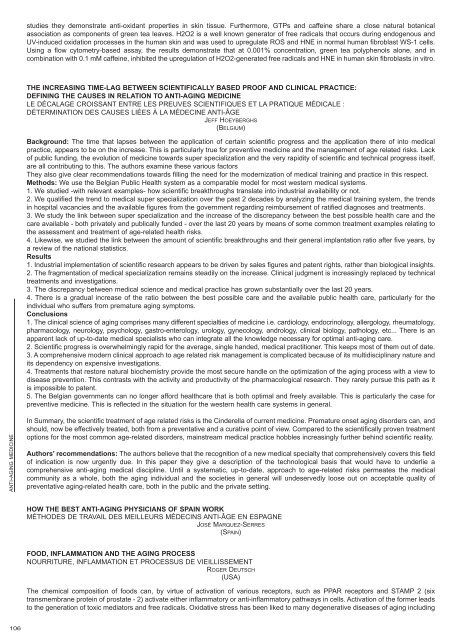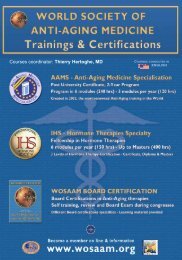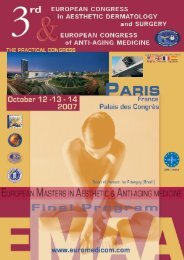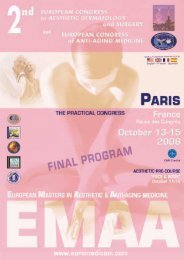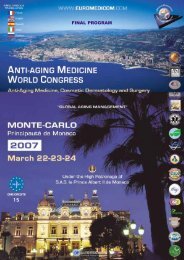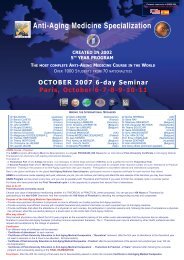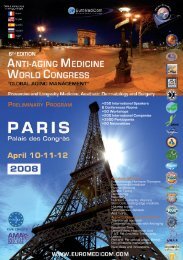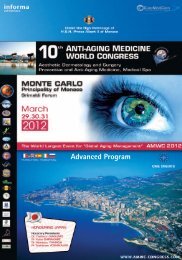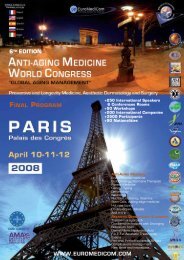FINAL PROGRAM 6TH EDITION - EuroMediCom
FINAL PROGRAM 6TH EDITION - EuroMediCom
FINAL PROGRAM 6TH EDITION - EuroMediCom
Create successful ePaper yourself
Turn your PDF publications into a flip-book with our unique Google optimized e-Paper software.
studies they demonstrate anti-oxidant properties in skin tissue. Furthermore, GTPs and caffeine share a close natural botanicalassociation as components of green tea leaves. H2O2 is a well known generator of free radicals that occurs during endogenous andUV-induced oxidation processes in the human skin and was used to upregulate ROS and HNE in normal human fibroblast WS-1 cells.Using a flow cytometry-based assay, the results demonstrate that at 0.001% concentration, green tea polyphenols alone, and incombination with 0.1 mM caffeine, inhibited the upregulation of H2O2-generated free radicals and HNE in human skin fibroblasts in vitro.THE INCREASING TIME-LAG BETWEEN SCIENTIFICALLY BASED PROOF AND CLINICAL PRACTICE:DEFINING THE CAUSES IN RELATION TO ANTI-AGING MEDICINELE DÉCALAGE CROISSANT ENTRE LES PREUVES SCIENTIFIQUES ET LA PRATIQUE MÉDICALE :DÉTERMINATION DES CAUSES LIÉES À LA MÉDECINE ANTI-ÂGEJEFF HOEYBERGHS(BELGIUM)Background: The time that lapses between the application of certain scientific progress and the application there of into medicalpractice, appears to be on the increase. This is particularly true for preventive medicine and the management of age related risks. Lackof public funding, the evolution of medicine towards super specialization and the very rapidity of scientific and technical progress itself,are all contributing to this. The authors examine these various factorsThey also give clear recommendations towards filling the need for the modernization of medical training and practice in this respect.Methods: We use the Belgian Public Health system as a comparable model for most western medical systems.1. We studied -with relevant examples- how scientific breakthroughs translate into industrial availability or not.2. We qualified the trend to medical super specialization over the past 2 decades by analyzing the medical training system, the trendsin hospital vacancies and the available figures from the government regarding reimbursement of ratified diagnoses and treatments.3. We study the link between super specialization and the increase of the discrepancy between the best possible health care and thecare available - both privately and publically funded - over the last 20 years by means of some common treatment examples relating tothe assessment and treatment of age-related health risks.4. Likewise, we studied the link between the amount of scientific breakthroughs and their general implantation ratio after five years, bya review of the national statistics.Results1. Industrial implementation of scientific research appears to be driven by sales figures and patent rights, rather than biological insights.2. The fragmentation of medical specialization remains steadily on the increase. Clinical judgment is increasingly replaced by technicaltreatments and investigations.3. The discrepancy between medical science and medical practice has grown substantially over the last 20 years.4. There is a gradual increase of the ratio between the best possible care and the available public health care, particularly for theindividual who suffers from premature aging symptoms.Conclusions1. The clinical science of aging comprises many different specialties of medicine i.e. cardiology, endocrinology, allergology, rheumatology,pharmacology, neurology, psychology, gastro-enterology, urology, gynecology, andrology, clinical biology, pathology, etc... There is anapparent lack of up-to-date medical specialists who can integrate all the knowledge necessary for optimal anti-aging care.2. Scientific progress is overwhelmingly rapid for the average, single handed, medical practitioner. This keeps most of them out of date.3. A comprehensive modern clinical approach to age related risk management is complicated because of its multidisciplinary nature andits dependency on expensive investigations.4. Treatments that restore natural biochemistry provide the most secure handle on the optimization of the aging process with a view todisease prevention. This contrasts with the activity and productivity of the pharmacological research. They rarely pursue this path as itis impossible to patent.5. The Belgian governments can no longer afford healthcare that is both optimal and freely available. This is particularly the case forpreventive medicine. This is reflected in the situation for the western health care systems in general.ANTI-AGING MEDICINEIn Summary, the scientific treatment of age related risks is the Cinderella of current medicine. Premature onset aging disorders can, andshould, now be effectively treated, both from a preventative and a curative point of view. Compared to the scientifically proven treatmentoptions for the most common age-related disorders, mainstream medical practice hobbles increasingly further behind scientific reality.Authors' recommendations: The authors believe that the recognition of a new medical specialty that comprehensively covers this fieldof indication is now urgently due. In this paper they give a description of the technological basis that would have to underlie acomprehensive anti-aging medical discipline. Until a systematic, up-to-date, approach to age-related risks permeates the medicalcommunity as a whole, both the aging individual and the societies in general will undeservedly loose out on acceptable quality ofpreventative aging-related health care, both in the public and the private setting.HOW THE BEST ANTI-AGING PHYSICIANS OF SPAIN WORKMÉTHODES DE TRAVAIL DES MEILLEURS MÉDECINS ANTI-ÂGE EN ESPAGNEJOSÉ MARQUEZ-SERRES(SPAIN)FOOD, INFLAMMATION AND THE AGING PROCESSNOURRITURE, INFLAMMATION ET PROCESSUS DE VIEILLISSEMENTROGER DEUTSCH(USA)The chemical composition of foods can, by virtue of activation of various receptors, such as PPAR receptors and STAMP 2 (sixtransmembrane protein of prostate - 2) activate either inflammatory or anti-inflammatory pathways in cells. Activation of the former leadsto the generation of toxic mediators and free radicals. Oxidative stress has been liked to many degenerative diseases of aging including106


